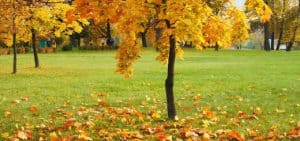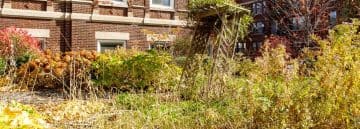
November is a mixed month in the garden. Warm, sunny days offer an ideal opportunity to get out into the garden and finish up important tasks, while frosty mornings warn about the season to come. Gardening tasks centre around maintenance and repair, as well as planting for next year’s growing season.
Tidy borders
Many annuals and herbaceous perennials begin to look tatty, brown and soggy at this time of year. Cut them back and add to the compost heap or they will encourage disease. Some herbaceous perennials may still be providing late colour, while many seed heads dry into attractive forms that will offer interest throughout the winter as well as food and cover for wildlife.
Clean out the greenhouse
One of the main jobs at this time of year is to clear out the greenhouse, wash pots, trays and containers, and clean and repair tools before putting them away for the winter. Clean the greenhouse thoroughly with disinfectant so that pests and disease do not have the opportunity to hibernate safely until spring.
Prepare your soil for next year
Carry on with the winter digging until the soil is too hard – use organic matter such as compost, manure and leaf mould to replace any nutrients removed during the growing season.
The RHS recommend adding a layer of organic matter and digging it in by turning over spadefuls so it is buried below the surface. If your soil is thin or heavy clay, just fork it over lightly now to avoid damaging the structure.
Planting
Plant bare-rooted trees, shrubs, hedging and roses as well as fruit trees and bushes. The plants are dormant but there is still enough warmth in the soil to allow them to become established before the harsh weather sets in.
Taking time to prepare the soil properly at this stage will pay dividends for years to come. After digging the hole or trench for your new plant dig in plenty of organic matter. Soak the root ball in water for an hour and plant to the same depth as before (look where the stem becomes darker), stake on the windward side to prevent rubbing, fill the hole and firm well. Mulch with a layer of organic matter and keep well watered.
Now is also the perfect time to plant soft fruits such as raspberries, gooseberries, blackberries and currants. Plant in well prepared soil enriched with plenty of compost or well rotted farmyard manure, to the same depth as they were before. Blackcurrants, however, should be planted lower than usual in the planting hole with 5cm of stem below ground level as this encourages new growth from the base of the plant.
Rake fallen leaves
Fallen leaves should be raked regularly during the Last 2014. A layer of leaves over lawned areas or borders stops light and air getting to plants and provides dark, damp conditions where slugs, snails and fungal diseases thrive. Leaves can be used to create the most wonderfully nutritious compost, or leaf mould, although avoid rose leaves, which often carry infection, and evergreen leaves, which take too long to rot down.
Bulbs and Flowers
Now is time to finish planting spring bulbs such as narcissi and crocuses if you have not done so already.
Many gardeners recommend planting tulip bulbs now as the cooler soil helps to avoid fungal disease. Bulbs can be used to fill gaps in beds and borders, in pots and containers, under shrubs and trees or naturalised in grass or woodland. If you are planting them in borders, groups of 10 – 25 between perennials give the best effect.
Bedding
Brighten your borders, hanging baskets and containers with winter bedding such as pansies, violas, primroses and cyclamen.
Perennials
Divide hearty perennials such as daylilies, Michaelmas daisies and golden rod. Cut them down to 4″, dig them up and divide carefully. If your soil is heavy clay, leave this job until springtime. All other perennials are also best left until the spring, especially peonies which dislike being split in cold weather and grasses.
Prune tall shrubs
Pruning can be carried out from now on throughout the dormant season. Once the leaves have fallen it is easier to see the overall shape and prune accordingly. Leave tender plants, evergreens and prunus varieties (ornamental cherries, plums and almonds) until spring. Prune tall shrubs by about half to protect them against wind rock.
Vegetables and herbs
Now is the time to plant garlic – sow individual cloves into well prepared ground so just the tip shows. Plant 15cm apart in rows 30 cm apart and the should be ripe by next November. Shallots can also be planted in the same way.
Plant broad beans and sow early peas such as Feltham First for early crops.
Protect cabbages and Brussels sprouts against pigeons with netting. Continue to harvest carrots, leeks, Brussels sprouts, carrots and parsnips (after a frost) as you need them for the kitchen.

